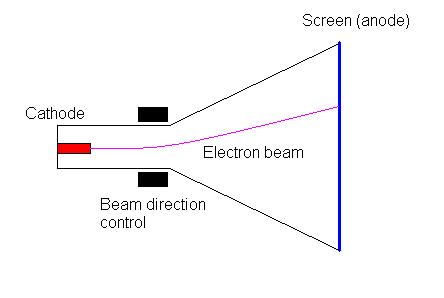How do monitors work?
Practically everyone has seen a monitor, either at their computer station, or as a TV in stores or their homes. The two most popular types of monitors are Cathode Ray Tube (CRT) and Liquid Crystal Display (LCD) monitors. The former has been used for decades as either a TV display or a computer monitor, while the latter has recently become commercially available and affordable.
A Cathode Ray Tube (CRT) was invented by a German physicist Karl Ferdinand Braun (1850-1918). A simple illustration of its design is shown in the figure below. The device consisted of a vacuum tube, which contained a cathode electron beam emitter on one side and a fluorescent screen on the other. The cathode produced a stream of electrons that was targetted towards the fluorescent screen. When the screen was bombarded by electrons, the portion subjected to the ray would light up for a short period of time, allowing an image to be visible. To make the image appear for a longer period of time, the image would have to be periodically recreated by controlling the electron beam.

There are generally two ways in which an image can be formed on a CRT. One way is to keep the intensity of the particle stream constant and then change where they hit the screen. This is in essence how an oscilloscope works. The other way it to fix a pattern in which the stream of particles hit the screen and then vary the intensity of the particle stream. In essence the second method allows an image or a shape to be drawn line by line. This is how an image on your computer screen is formed.
As the technology matured the quality of the image produced by a CRT was increased, first by producing a sharper image and then by adding colour to it. The former was achieved through a finer control of the electron beam allowing smaller and smaller fragments of the screen to be illuminated independently. The latter became possible by replacing the fluorescent coating with a phosphor coating with three different colours - red, green and blue. The screen became a mesh of dots of these three colours. Because the dots are really small (less than a quarter of a milimeter) a group of these dots appears to a human eye as a single point. By controlling the intensity of each of the colours in the dot triplet (red, green, blue) almost any colour can be produced.
Controlling the display
In the 1980s as the Personal Computers became more and more popular it was necessary to create a standardized way to control the CRT, especially from a computer programmer's the point of view. This was done by abstracting the CRT screen as a grid of picture elements (pixels). Each pixel was comprised of a group of (red, green, blue) dot triplets. The screen could then be thought of as having x columns and y rows of pixels, which could be easily manipulated on a computer. Many display standards emerged, each with a different number of rows, columns and colours.
One of such standards was introduced by International Business Machines (IBM) in 1987. It is called the Video Graphics Array and defined a way to display an image 640 pixels wide by 480 rows high (known as 640 by 480 resolution) with 16 colours. Since then the number of colours supported at the resolution of 640 by 480 has increased, but the way to control the monitor in this resolution has remained the same.
In the related pages we describe a VGA adapter, which implements the hardware necessary to control a monitor in a 640 by 480 resolution. It abstracts the inner workings of the monitor to the point of it being perceived strictly as an array of pixels that you can easily control.